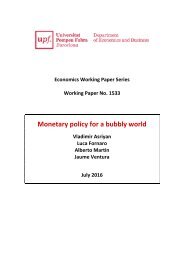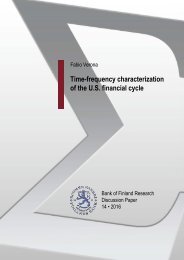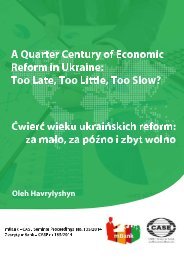Necessity as the mother of invention monetary policy after the crisis
n?u=RePEc:dnb:dnbwpp:525&r=mac
n?u=RePEc:dnb:dnbwpp:525&r=mac
You also want an ePaper? Increase the reach of your titles
YUMPU automatically turns print PDFs into web optimized ePapers that Google loves.
governors feel that <strong>the</strong>y did not receive a lot <strong>of</strong> criticism for acting politically or crossing<br />
<strong>the</strong> line into <strong>the</strong> political realm during <strong>the</strong> <strong>crisis</strong>, most academic respondents think that<br />
central banks were criticized for crossing <strong>the</strong> line into politics.<br />
2. CENTRAL BANK GOALS<br />
The global financial <strong>crisis</strong> challenged important elements <strong>of</strong> <strong>the</strong> pre-existing consensus<br />
that <strong>monetary</strong> <strong>policy</strong> should be aimed at price stability and should use just one instrument:<br />
a short-term <strong>policy</strong> interest rate. But no new consensus h<strong>as</strong> yet been reached. In our view,<br />
several elements <strong>of</strong> <strong>the</strong> pre-<strong>crisis</strong> consensus, such <strong>as</strong> central bank independence and <strong>the</strong><br />
focus on long-term price stability, remain valid today. O<strong>the</strong>r elements, however, may have<br />
to be rethought.<br />
Figure 1. Discussions about <strong>the</strong> central bank mandate outside <strong>of</strong> <strong>the</strong> central bank<br />
Notes: The left-hand chart shows whe<strong>the</strong>r, according to central bank governors, a discussion took<br />
place outside <strong>the</strong> central bank about changing <strong>the</strong> mandate. The right-hand side chart shows <strong>the</strong><br />
changes that were discussed (in % <strong>of</strong> <strong>the</strong> respondents who answered “Yes”). The explanations<br />
provided in <strong>the</strong> survey indicate that when governors answer “o<strong>the</strong>r”, <strong>the</strong>y mostly refer to<br />
discussions on adding financial stability. Source: Authors’ calculations b<strong>as</strong>ed on a survey<br />
conducted in 2016.<br />
To <strong>as</strong>sess central bankers’ view on whe<strong>the</strong>r <strong>the</strong>ir mandates had changed, we <strong>as</strong>ked two<br />
questions in our survey. The first pertained to external opinions and influences: “Did <strong>the</strong><br />
world financial <strong>crisis</strong> <strong>of</strong> 2007-2009 and/or its <strong>after</strong>math create discussions in your country<br />
but outside your central bank about whe<strong>the</strong>r it would be desirable to modify <strong>the</strong> bank’s<br />
mandate in any way? If “Yes,” were those discussions about: (ple<strong>as</strong>e check <strong>as</strong> many <strong>as</strong><br />
apply)”. As <strong>the</strong> left-hand chart in Figure 1 shows, <strong>the</strong> answers to <strong>the</strong> “yes or no” question<br />
literally comprised a bottle half full and half empty. Exactly half <strong>the</strong> governors answered<br />
“yes,” which surprised us a bit on <strong>the</strong> low side.<br />
We <strong>as</strong>ked <strong>the</strong> same two questions about discussions within central banks: “Did <strong>the</strong> world<br />
financial <strong>crisis</strong> <strong>of</strong> 2007-2009 and/or its <strong>after</strong>math create discussions inside your central<br />
bank about whe<strong>the</strong>r it would be desirable to modify <strong>the</strong> bank’s mandate in any way?<br />
(ple<strong>as</strong>e check one)” and “If “Yes,” were those discussions about: (ple<strong>as</strong>e check <strong>as</strong> many<br />
5








